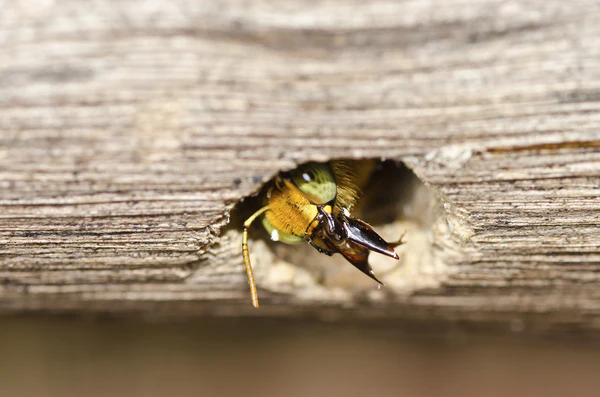Carpenter bees can be a significant nuisance for homeowners, especially those with wooden structures. Understanding their behavior and finding effective methods to deter them is crucial for maintaining the integrity of your home. In this guide, we will explore carpenter bee behavior, natural repellents and deterrents, building and yard modifications, and long-term management strategies. By the end of this article, you’ll have a comprehensive understanding of what keeps carpenter bees away and how to protect your property effectively.
Carpenter Bee Behavior
Carpenter bees are often mistaken for bumblebees due to their similar appearance. However, their behavior sets them apart, particularly their nesting and wood-boring activities. Unlike bumblebees, carpenter bees do not live in colonies. Instead, they are solitary creatures, with each female bee creating her own nest.
Nesting and Wood-Boring Activities
Carpenter bees are named for their ability to bore into wood to create nesting sites. They prefer untreated or weathered wood, making structures such as eaves, siding, decks, and fences prime targets. The female carpenter bee uses her strong mandibles to chew circular holes, creating tunnels where she lays her eggs. These tunnels can cause structural damage over time, leading to costly repairs.
Natural Repellents and Deterrents
One of the first steps in preventing carpenter bees from settling in your wood structures is using natural repellents and deterrents. These methods can be effective in making your property less attractive to these pests.
Essential Oils
Essential oils are a popular and eco-friendly way to repel carpenter bees. Oils such as citrus, tea tree, eucalyptus, and lavender are known for their strong scents, which are unpleasant to bees. To use essential oils, mix a few drops with water in a spray bottle and apply it to areas where carpenter bees are likely to nest. Regular application is necessary, especially after rain.
Sound Devices
Carpenter bees are sensitive to vibrations and sounds. Ultrasonic pest repellers emit high-frequency sound waves that are irritating to these insects. Placing these devices near wooden structures can discourage bees from nesting. Ensure the device covers the area effectively for the best results.
Visual Deterrents
Visual deterrents can also play a role in keeping carpenter bees away. Shiny, reflective objects such as aluminum foil or reflective tape can confuse and deter bees. Hanging these objects near vulnerable wooden areas can prevent bees from approaching. Additionally, painting wood surfaces with glossy paint can make them less attractive to carpenter bees.
Building and Yard Modifications
Making modifications to your building and yard can significantly reduce the likelihood of carpenter bee infestations. Here are some effective strategies:
Selecting the Right Wood
Choosing the right type of wood for your structures can make a difference. Carpenter bees prefer softwoods such as pine, cedar, and redwood. Opting for hardwoods like oak, maple, or walnut can deter them. If softwoods are necessary, consider treating them to make them less appealing to bees.
Treating Existing Structures
If you already have wooden structures that carpenter bees are attracted to, treating the wood can help. Applying a wood preservative or sealant can create a barrier that makes it difficult for bees to bore into the wood. Regular maintenance and reapplication of these treatments are crucial to maintaining their effectiveness.
Long-Term Management
While natural repellents and building modifications can be effective, long-term management strategies are essential to ensure carpenter bees do not become a recurring problem.
Regular Inspections
Conducting regular inspections of your property is key to early detection and prevention. Look for signs of carpenter bee activity, such as small holes in wood surfaces or sawdust beneath these holes. Early detection allows you to take action before significant damage occurs.
Professional Pest Control Options
In cases where carpenter bee infestations are severe or persistent, seeking professional pest control services may be necessary. Pest control professionals have the expertise and tools to manage and eliminate carpenter bee populations effectively. They can also provide advice on preventing future infestations.
For more detailed information on keeping bees away, you can check out The Ultimate Guide to Keeping Bees Away.
Conclusion

Carpenter bees, with their wood-boring activities, can cause considerable damage to your property. Understanding their behavior and implementing a combination of natural repellents, building modifications, and long-term management strategies can protect your home effectively. Regular inspections and professional pest control options ensure that carpenter bee infestations are kept at bay. By following these strategies, you can maintain the structural integrity of your wooden structures and enjoy a carpenter bee-free environment.

Dr. Emily Turner is a board-certified physician specializing in holistic health and wellness. With over 15 years of experience in the medical field, she combines her extensive knowledge in nutrition, fitness, and mental health to provide comprehensive advice and insights. Emily is dedicated to helping readers achieve a balanced and healthy lifestyle through her expert articles and guides.




